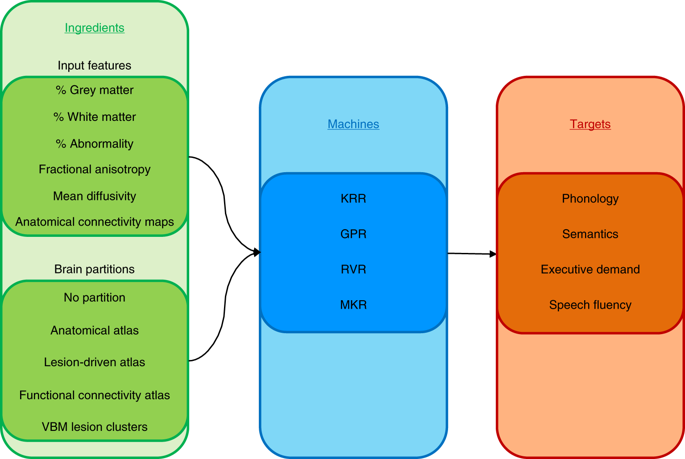当前位置:
X-MOL 学术
›
Nat. Hum. Behav.
›
论文详情
Our official English website, www.x-mol.net, welcomes your
feedback! (Note: you will need to create a separate account there.)
Investigating the effect of changing parameters when building prediction models for post-stroke aphasia.
Nature Human Behaviour ( IF 21.4 ) Pub Date : 2020-04-20 , DOI: 10.1038/s41562-020-0854-5 Ajay D Halai 1 , Anna M Woollams 2 , Matthew A Lambon Ralph 1
Nature Human Behaviour ( IF 21.4 ) Pub Date : 2020-04-20 , DOI: 10.1038/s41562-020-0854-5 Ajay D Halai 1 , Anna M Woollams 2 , Matthew A Lambon Ralph 1
Affiliation

|
Neuroimaging has radically improved our understanding of how speech and language abilities map to the brain in normal and impaired participants, including the diverse, graded variations observed in post-stroke aphasia. A handful of studies have begun to explore the reverse inference: creating brain-to-behaviour prediction models. In this study, we explored the effect of three critical parameters on model performance: (1) brain partitions as predictive features, (2) combination of multimodal neuroimaging and (3) type of machine learning algorithms. We explored the influence of these factors while predicting four principal dimensions of language and cognition variation in post-stroke aphasia. Across all four behavioural dimensions, we consistently found that prediction models derived from diffusion-weighted data did not improve performance over models using structural measures extracted from T1 scans. Our results provide a set of principles to guide future work aiming to predict outcomes in neurological patients from brain imaging data.
中文翻译:

研究在构建卒中后失语症预测模型时改变参数的影响。
神经影像学从根本上提高了我们对正常和受损参与者的言语和语言能力如何映射到大脑的理解,包括在中风后失语症中观察到的多样化、分级变化。一些研究已经开始探索反向推理:创建大脑到行为的预测模型。在这项研究中,我们探讨了三个关键参数对模型性能的影响:(1)作为预测特征的大脑分区,(2)多模态神经成像的组合和(3)机器学习算法的类型。我们探讨了这些因素的影响,同时预测了中风后失语症的语言和认知变异的四个主要维度。在所有四个行为维度上,我们始终发现,与使用从 T1 扫描中提取的结构测量的模型相比,源自扩散加权数据的预测模型并没有提高性能。我们的结果提供了一套原则来指导未来的工作,旨在从脑成像数据预测神经系统患者的结果。
更新日期:2020-04-24
中文翻译:

研究在构建卒中后失语症预测模型时改变参数的影响。
神经影像学从根本上提高了我们对正常和受损参与者的言语和语言能力如何映射到大脑的理解,包括在中风后失语症中观察到的多样化、分级变化。一些研究已经开始探索反向推理:创建大脑到行为的预测模型。在这项研究中,我们探讨了三个关键参数对模型性能的影响:(1)作为预测特征的大脑分区,(2)多模态神经成像的组合和(3)机器学习算法的类型。我们探讨了这些因素的影响,同时预测了中风后失语症的语言和认知变异的四个主要维度。在所有四个行为维度上,我们始终发现,与使用从 T1 扫描中提取的结构测量的模型相比,源自扩散加权数据的预测模型并没有提高性能。我们的结果提供了一套原则来指导未来的工作,旨在从脑成像数据预测神经系统患者的结果。










































 京公网安备 11010802027423号
京公网安备 11010802027423号